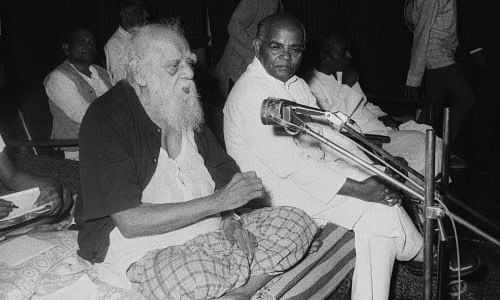
"The duty and the responsibility of a rationalist is to thoughtfully and promptly carry out his actions, in fraternal affection, without considering country, language, God, religion and caste." — Periyar
Amit Shah, on the occasion of Hindi Diwas, said that the nation boasts numerous dynamic streams of languages yet argued for Hindi to be made the national language.
The idea threatened the basic tenet of 'unity in diversity' and bore the premonition of wiping out diverse cultures that comprise India.
This is a good time to look back 90 years — to the summer of 1929, the year of E V Ramasamy ‘Periyar’s’ revolution. September 17 also happens to be the day of his birth in 1879.
Periyar’s ideas can be described as a manifestation of the 'Tamil sentiment’ when faced with what can be characterised as Hindi aggression. He laid the first steps towards abolishing caste identity, language imposition and most importantly, incorporating feminism into the resistance movement he led.
Feminist intervention
This is an aspect that is not given too much attention, but feminism for Periyar was not a separate struggle but entwined with every aspect of independence. As a part of his significant 'Self-respect movement' where 37 of the 77 women who participated from Madras, in 1938, were jailed with their infants, fighting for their language.
The struggle included prominent women Tamil figures such as Ramamritham Ammaiyar, Narayani Ammaiyar, Va. Ba. Thamaraikanni Ammaiyar, Munnagaara Azhagiyar who were also arrested.
Even in his book published in 1942, Pen Yen Adimaiyanal (Why did woman become enslaved), he imparted his views on contraception, choice of a life partner, divorce and remarriage.
Opposition to Hindi
Pre-independent India was still rife with caste and gender discrimination, especially drawing a deep distinction between the Brahmins and non-Brahmins. Hindi was seen as a form of Brahminical domination, as it is known to have evolved from Sanskrit — the Vedic language which was traditionally restricted to upper-caste men.
The Self-respect movement of EVR sought to uproot the caste system that had spread its branches, shadowing the development of various sections of people. The movement focused on imbibing a sense of pride in the minds of the non-Brahmin class about their Dravidian origin and not be suffocated by a language which was believed to be the "unifying factor”. Periyar himself was fluent in three Dravidian tongues: Kannada, Telugu and Tamil.
Hindi imposition became a matter of controversy since Rajaji's rule as the chief minister of the Madras Presidency in 1937. C Rajagopalachari aka ‘Rajaji’ had introduced a new law in the Madras Presidency regions, making Hindi a compulsory language in schools, during the first Congress government in 1937.
Unlike the current short-lived spurs of the Opposition, the movement went on for three years in Tamil Nadu. Protests, conferences, fasts, bandhs and arrests of about 1200 people to bring down the law. The law was finally scrapped by the British Governor of Madras Lord Erskine on February 1940, post the fall of the Congress government in 1939.
Periyar evolved from a theist to an atheist, to a rebel, to a leader and then transcended to become an idea. An idea that emotes the sense of what 'Tamil' is and what it means to the Tamils.
Former Prime Minister Jawaharlal Nehru implemented the Official languages Act of 1963 to take down the notion of Hindi as the official language since it was refuted by many non-Hindi Indian states, who wanted the continued use of English.
This is the year 2019, and Hindi imposition continues - in the absence of one Periyar EV Ramasamy.